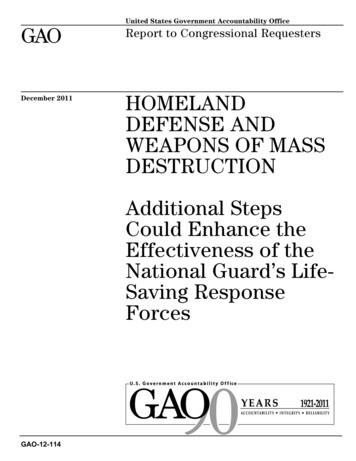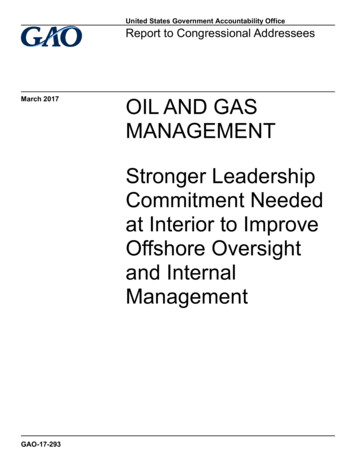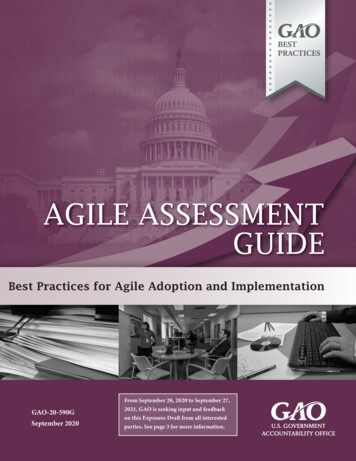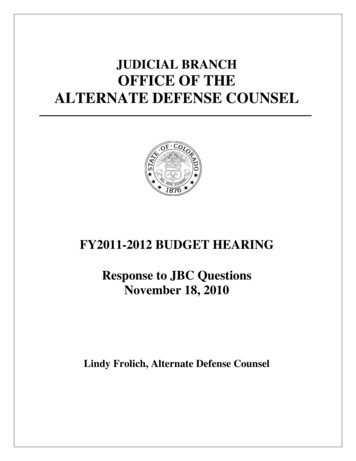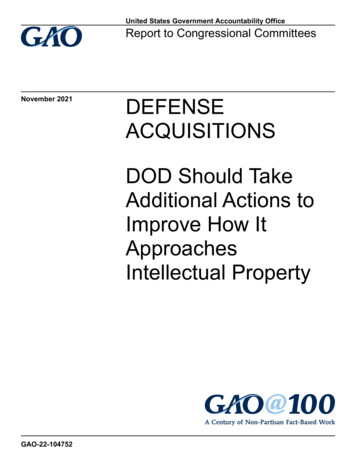
Transcription
United States Government Accountability OfficeReport to Congressional CommitteesNovember 2021DEFENSEACQUISITIONSDOD Should TakeAdditional Actions toImprove How ItApproachesIntellectual PropertyGAO-22-104752
DEFENSE ACQUISITIONSDOD Should Take Additional Actions to Improve How ItApproaches Intellectual PropertyNovember 2021Highlights of GAO-22-104752, a report to congressional committeesWhy This MattersDepartment of Defense Intellectual Property CadreThe Department of Defense (DOD) acquires andlicenses intellectual property (IP)—such as computersoftware and technical data—for its cutting-edgeweapon systems. Yet, DOD often does not acquire theIP it needs to operate and maintain those systems,which can lead to surging costs later. In 2019, DODassigned specific IP responsibilities to organizationswithin the department.Key TakeawaysDOD organizations are working to meet their assignedIP responsibilities. However, DOD has not fullyaddressed how the IP Cadre—DOD’s new group ofspecialized experts—will fulfill all of its responsibilities.The IP Cadre faces uncertainty in these areas: Funding and staffing: DOD currently plans to providethe Director of the IP Cadre and his team in theOffice of the Secretary of Defense (OSD) withfunding for five positions through fiscal year 2023. IPCadre members told us the temporary positionswere a disincentive during the hiring process andcould present future staffing obstacles. Program support: The members of the IP Cadre atOSD expect to tap into a larger pool of IP expertsacross DOD to support program offices by helpingthem develop IP strategies and negotiate withcontractors, among other things. However, DOD hasnot yet detailed how the Director of the IP Cadre andthe OSD team will work with these other experts. Expertise: DOD officials said the department lackssufficient expertise in two key areas—IP valuation(determining its worth) and financial analysis. DODis currently conducting a pilot project to studyvaluation strategies. However, DOD officials saidmore work is needed to provide this expertise.Determining the IP Cadre’s staffing and resource needswill help DOD better position the IP Cadre for success.How GAO Did This StudyWe reviewed guidance, reports, and documentation onIP issues; interviewed DOD personnel, military officials,and industry groups; and reviewed the existingregulatory and agency frameworks related to IP.What GAO RecommendsWe made four recommendations to DOD, including thatDOD should determine the collaboration, staffing, andresources needed across DOD to execute its proposedapproach for the IP Cadre. DOD concurred with all fourrecommendations.For more information, contact: Timothy J. DiNapoli at (202)512-4841 or DinapoliT@gao.gov.United States Government Accountability Office
ContentsLetter1BackgroundDOD’s IP Instruction Highlights Six Core Principles, but Does NotAddress DOD’s Ability to Obtain Detailed Manufacturing orProcess DataDOD Is Taking Steps to Implement the IP Instruction, but Has NotFully Identified How the IP Cadre Will Meet Its AssignedResponsibilitiesDAU Is Working to Improve IP Training, but Its Strategic PlanLacks Priorities, and the IP Cadre Has Not SpecificallyIdentified Which DOD Personnel Should Take the TrainingDOD Has Taken Initial Steps to Develop a Capability to Track IP ItHas Licensed or AcquiredConclusionsRecommendations for Executive ActionAgency Comments and GAO Response28282929Proposed Changes to the Defense Federal Acquisition RegulationSupplement Related to Intellectual Property32Appendix IIComments from the Department of Defense34Appendix IIIGAO Contact and Staff Acknowledgments37Appendix I5141825TablesTable 1: Actions Taken to Address Key ResponsibilitiesEstablished in DOD’s Intellectual Property (IP) InstructionTable 2: Examples of How Military Departments Are AddressingResponsibilities Established in DOD’s Intellectual Property(IP) InstructionTable 3: Intellectual Property (IP) Cadre Responsibilities in DOD’sIP InstructionTable 4: Open Defense Federal Acquisition RegulationSupplement (DFARS) Cases Related to IntellectualProperty, as of September 2021Page i18192032GAO-22-104752 DOD Intellectual Property
FiguresFigure 1: Types of Intellectual PropertyFigure 2: Types of License Rights for Intellectual Property (IP)Figure 3: Key IP-Related NDAA Provisions from Fiscal Years2016-2021Figure 4: DOD’s Extended Rulemaking Timeline for SelectedRegulatory Changes Involving Intellectual Property (IP)Figure 5: Proposed Federated Structure for DOD’s IntellectualProperty (IP) DFARSDODDMPDFARFYIPIP CadreMOSAOIRAOFPPOMBOSDOTAOUSD(A&S)USCAssistant Secretary of Defense for AcquisitionDirector of Acquisition Career ManagementDefense Acquisition RegulationsDefense Acquisition Regulations SystemDefense Acquisition UniversityDefense Acquisition Workforce Development AccountDefense Federal Acquisition Regulation SupplementDepartment of Defensedetailed manufacturing or process dataFederal Acquisition Regulationfiscal yearintellectual propertycadre of intellectual property expertsmodular open systems approachOffice of Information and Regulatory AffairsOffice of Federal Procurement PolicyOffice of Management and BudgetOffice of the Secretary of Defenseother transaction authoritiesOffice of the Under Secretary of Defense for Acquisitionand SustainmentUnited States CodeThis is a work of the U.S. government and is not subject to copyright protection in theUnited States. The published product may be reproduced and distributed in its entiretywithout further permission from GAO. However, because this work may containcopyrighted images or other material, permission from the copyright holder may benecessary if you wish to reproduce this material separately.Page iiGAO-22-104752 DOD Intellectual Property
Letter441 G St. N.W.Washington, DC 20548November 30, 2021Congressional CommitteesThe Department of Defense (DOD) acquires and licenses intellectualproperty (IP)—including technical data, computer software, and usermanuals—from companies to operate and maintain its cutting-edgeweapon systems and other equipment it purchases. Acquiring andlicensing IP is critical for ensuring these systems and equipment remainfunctional, sustainable, upgradable, and affordable. Additionally, wepreviously reported that companies told us intellectual property isessential to their survival, calling it the life-blood of their enterprise. 1 Assuch, transactions that affect the ownership, control, or transfer of IP canhave enormous implications for parties on both sides.Over the past 3 decades, we reported on some of the consequences ofDOD not acquiring IP for weapon systems, including reduced missionreadiness and surging sustainment costs. For example, in July 2021, wereported that technical data issues have negatively affected missionreadiness for the F-35 program. 2 Specifically, we found that key enginerepairs took longer than expected, in part, because the technical dataavailable to maintenance providers was insufficient for the level ofmaintenance required. In March 2020, we also reported that a lack oftechnical data contributed to sustainment problems for several Navy shipprograms, and that focusing on sustainment issues—such as determiningneeded IP and acquiring it earlier in the acquisition process—could savebillions of dollars. 3Congress has directed DOD to take several steps in recent years to try toimprove how the department acquires IP. For example, the Fiscal Year2018 National Defense Authorization Act (NDAA) directed DOD toestablish an IP acquisition or licensing policy and a cadre of IP experts1GAO,Military Acquisitions: DOD Is Taking Steps to Address Challenges Faced byCertain Companies, GAO-17-644 (Washington, D.C.: July 20, 2017).2GAO, F-35 Sustainment: DOD Needs to Cut Billions in Estimated Costs to AchieveAffordability, GAO-21-439 (Washington, D.C.: July 7, 2021); and F-35 Sustainment:Enhanced Attention to and Oversight of F-35 Affordability Are Needed, GAO-21-505T(Washington, D.C.: Apr. 22, 2021).3GAO,Navy Shipbuilding: Increasing Focus on Sustainment Early in the AcquisitionProcess Could Save Billions, GAO-20-2 (Washington, D.C.: Mar. 24, 2020).Page 1GAO-22-104752 DOD Intellectual Property
(IP Cadre). 4 Subsequently, in October 2019, DOD issued an overarchingIP Instruction, which establishes IP-related responsibilities for specificDOD officials and organizations, including the IP Cadre, militarydepartments, and the Defense Acquisition University (DAU). 5 DAU isresponsible for providing acquisition training, educational resources, anda learning platform to DOD personnel.In the Fiscal Year 2021 NDAA, Congress included a provision for us toreview DOD’s efforts to improve IP acquisitions and licensing. 6 This report(1) examines issues addressed in DOD’s IP Instruction, (2) examines theextent to which DOD has implemented the IP Instruction, (3) assessesDAU’s efforts to improve IP training, and (4) describes DOD’s efforts todevelop a capability to track the IP the department has acquired andlicensed.To examine issues addressed in DOD’s IP Instruction, we reviewed theinstruction and compared its content to the requirements in the statutoryand regulatory framework for DOD’s IP acquisitions. This frameworkincludes applicable provisions of Title 10 of United States Code, theFederal Acquisition Regulation (FAR), and the Defense FederalAcquisition Regulation Supplement (DFARS). 7 We also reviewed priorand current DOD IP guidance and reports to Congress on IP issues,including past and current iterations of DOD’s overarching acquisitioninstruction (DOD Instruction 5000.02). 8 We reviewed the extent to which4NationalDefense Authorization Act for Fiscal Year 2018, Pub. L. No. 115-91, § 802.5For the purposes of this report, the “acquisition of intellectual property” includes theacquisition of technical data rights in manuals, drawings, and reports, and other technicalmaterial, computer software, and any licenses. For example, see DOD Instruction5010.44, Intellectual Property Acquisition and Licensing (Oct. 16, 2019), pg. 3.6NationalDefense Authorization Act for Fiscal Year 2021, Pub. L. No. 116-283, § 839.7TheFAR was established for the codification and publication of uniform policies andprocedures for acquisition by all executive agencies. FAR 1.101. The DFARS implementsand supplements the FAR for DOD.8Forexample, see Department of Defense (DOD) Instruction 5000.02, Operation of theDefense Acquisition System (Jan. 7, 2015) (incorporating Change 4, Aug. 31, 2018). Themost recent revision to the DOD Instruction 5000.02 was effective January 23, 2020.Department of Defense, Report to Congress On Pilot Program on Intellectual PropertyEvaluation for Acquisition Programs Section 801 of the National Defense Authorization Actfor Fiscal Year 2020 (March 2021); Report to Congress on Intellectual Property Policy andthe Cadre of Intellectual Property Experts Section 838 of the National DefenseAuthorization Act for Fiscal Year 2020 (April 2020); and 2018 Report Government-IndustryAdvisory Panel on Technical Data Rights (Nov. 13, 2018).Page 2GAO-22-104752 DOD Intellectual Property
the Office of the Under Secretary of Defense for Acquisition andSustainment (OUSD (A&S)) solicited and incorporated stakeholder inputon the IP Instruction. To do this, we reviewed the formal commentsreceived during the development of the draft instruction, and interviewedthe Director of the IP Cadre and representatives from DOD’s acquisition,sustainment, and innovation communities. We also reviewed the publiccomments provided for eight proposed DFARS rule changes involving IP,which were almost all directed by NDAAs from fiscal years 2012 to 2021. 9Additionally, to obtain perspectives on IP issues and challenges andidentify input provided to DOD on the IP Instruction, we interviewed DODofficials responsible for implementing the IP Instruction, including Army,Air Force, and Navy officials tasked with supporting IP licensing andacquisitions, and sustaining weapon systems. We interviewedrepresentatives from a nongeneralizable sample of six industry groupsrepresenting small, large, traditional, and non-traditional contractorsincluding: (1) Aerospace Industries Association; (2) National ArmamentsConsortium; (3) National Defense Industrial Association; (4) National 8(a)Association; (5) Professional Services Council; and (6) Small BusinessTechnology Council. The information and communication component ofinternal control—management’s use of quality information to support theinternal control system—was significant to this objective, along with therelated principle that management should internally communicate thenecessary quality information to achieve the entity’s objectives. Weassessed the extent to which the DOD IP instruction communicatesnecessary quality information to interpret and explain IP-relatedregulations and policies.To examine the extent to which DOD has implemented the IP Instruction,we reviewed the responsibilities outlined in DOD’s October 2019 IPInstruction and collected and reviewed documentation of how the IPCadre and other DOD offices are meeting their responsibilities, in part byusing a structured checklist. 10 We also reviewed DOD’s implementationplans for the IP Cadre outlined in April 2020 and March 2021 reports toCongress and compared them to federal implementation planning9Seeappendix I for more information on the eight proposed rule changes.10We provided structured checklists to OUSD (A&S), DAU, DOD General Counsel, the IPCadre, and the Departments of the Army, Air Force, and Navy. Representatives from eachoffice completed and returned the checklists during the course of this audit.Page 3GAO-22-104752 DOD Intellectual Property
guidance. 11 We interviewed the members of the IP Cadre and officialsfrom the Army, Air Force, and Navy about their efforts to implement the IPInstruction. Additionally, we interviewed officials from two defenseinnovation offices that often engage with non-traditional defensecontractors—the Defense Advanced Research Projects Agency and theDefense Innovation Unit—and executives from the six industry groupsabout how implementation of the IP Instruction has affected DOD’s IPacquisitions to date.To assess DAU’s efforts to improve IP training, we reviewed IP learningresources found on DAU’s IP Community of Practice web portal, as wellas DAU’s 5-year strategic plan for improving its IP curricula, which wecompared to government-wide guidance for strategic planning. 12 Weinterviewed DAU officials and members of the IP Cadre about theircoordination and efforts to develop tailored IP training for a range of DODcareer fields spanning DOD’s acquisition workforce, including trainingmodules and courses containing IP content and mission assistanceactivities. We also interviewed the Director of Acquisition CareerManagement (DACM) representatives and other officials at each of themilitary departments about their roles in ensuring that the workforcereceives appropriate IP training. Finally, we attended all seven coursesrequired for DAU’s foundational IP credential and reviewed new trainingmaterials on key IP topics.To describe DOD’s efforts to develop a capability to track the IP thedepartment has acquired or licensed, we reviewed documentation onDOD’s plans to develop and test such a capability. We also reviewed a2018 report issued by a panel of government and industry experts thatdescribed the challenges of not having the capability to track IP. 13Additionally, we interviewed DOD officials about the need for such acapability and DOD’s plans to develop it.We conducted this performance audit from January 2021 to November2021 in accordance with generally accepted government auditing11Office of Management and Budget, Preparation, Submission, and Execution of theBudget, Circular No. A-11 (August 2021).12Id.13NationalDefense Authorization Act for Fiscal Year 2016, Pub. L. No. 114-92, § 813. Thepanel issued its final report, 2018 Report Government-Industry Advisory Panel onTechnical Data Rights, in November 2018. The report examined long-standing tensionpoints between government and industry regarding rights to technical data and maderecommendations for legislative, regulatory, and policy changes.Page 4GAO-22-104752 DOD Intellectual Property
standards. Those standards require that we plan and perform the audit toobtain sufficient, appropriate evidence to provide a reasonable basis forour findings and conclusions based on our audit objectives. We believethat the evidence obtained provides a reasonable basis for our findingsand conclusions based on our audit objectives.BackgroundRegulations GoverningIntellectual PropertyCategoriesCompanies protect their IP in several ways, including the use of patents,trademarks, copyrights, and trade secrets. 14 See figure 1 for more detailson these types of IP categories.Figure 1: Types of Intellectual PropertyCongress has enacted several laws related to IP over the past severaldecades. 15 For example, in 1980, Congress passed the Bayh-Dole Act,which addressed patent rights in inventions made with federalassistance. 16 The act addressed the rights of small businesses,14Foradditional information, see GAO, Intellectual Property: Additional Agency ActionsCan Improve Assistance to Small Businesses and Inventors, GAO-20-556 (Washington,D.C.: Aug. 27, 2020); and Intellectual Property: Industry and Agency Concerns OverIntellectual Property Rights, GAO-02-723T (Washington, D.C.: May 10, 2002).15For the purposes of this report, we use the definition of intellectual property from DODInstruction 5010.44: information, products, or services that are protected by law asintangible property, including data (e.g., technical data and computer software), technicalknow-how, inventions, creative works of expression, and trade names.16The Patent and Trademark Law Amendments Act of 1980 (Bayh-Dole Act), 35 U.S.C.§§ 200–211, 301–307.Page 5GAO-22-104752 DOD Intellectual Property
universities, and other nonprofit organizations and generally gave themthe right to retain title to subject inventions, provided they adhered tocertain requirements. 17 In 1983, an executive order stated that it grantedto all contractors, regardless of size, the title to patents made in whole orin part with federal funds. 18 The following year, Congress passed theDefense Procurement Reform Act, which required that regulationsaddress rights in technical data, including procedures to validate anyproprietary data restrictions asserted by contractors. 19The FAR and DFARS implement these laws and provide the basicregulatory framework governing how DOD may license and acquirecontractor IP. 20 For example, these regulations describe how thegovernment may obtain technical data rights and licenses to computersoftware. 21 In general, using another entity’s IP requires permission, andthe government typically uses licenses to obtain permission and definethe scope of its rights to use a particular contractor’s IP. The federalgovernment also obtains data rights when the development of IP wasfunded by the government—in whole or in part— and the types of datarights obtained by the government generally depend on how the IP wasdeveloped and funded. 22 Federal acquisition regulations established datarights, which can be organized into three categories (see fig. 2). 2317Id. A ‘subject invention’ was defined as any invention of the contractor conceived or firstactually reduced to practice in the performance of work under a funding agreement.18President’s Memorandum to the Heads of the Executive Departments and Agencies,Government Patent Policy (Feb. 18, 1983); Exec. Order No. 12,591, § 1(b)(4), 52 Fed.Reg. 13,414 (Apr. 10, 1987).19DefenseProcurement Reform Act, 1984, Pub. L. No. 98-525, § 1201.20For example, see 10 U.S.C. §§ 2320 & 2321; DFARS § 252.227.71 (Rights in TechnicalData); DFARS § 252. 227.72 (Rights in Computer Software and Computer SoftwareDocumentation); and DFARS 252.227-7013, -7014, -7015, -7017, -7018, -7019, -7026, 7027, -7030, and -7037.21Technical data includes any recorded information of a scientific or technical nature suchas product design or maintenance data and computer software documentation. Computersoftware includes executable code, source code, code listings, design details, processes,flow charts, and related materials. See DFARS 252.227-7013, -7014.22Data rights are also determined by whether the item, process, or software is commercialor non-commercial, and the purpose of the data in question.23The government obtains technical data and license rights to use IP assets inaccordance with the FAR, agency supplements to the FAR, and any specificallynegotiated licenses in the contract. These rights control how the government can use,disclose, or reproduce contractor owned information.Page 6GAO-22-104752 DOD Intellectual Property
Figure 2: Types of License Rights for Intellectual Property (IP)Note: Table does not represent every license right available to DOD within federal acquisitionregulations. “Limited rights” refer to those rights in technical data, and “Restricted rights” refer tothose rights in noncommercial software.Regardless of the source of funding used for IP development, thegovernment obtains unlimited rights to form, fit, and function data anddata necessary for operation, maintenance, installation, and trainingpurposes. Not included within those exceptions are detailedmanufacturing or process data (DMPD), including the steps, sequences,and assembly used by manufacturers to produce an item.Recent CongressionalAction to Improve HowDOD Acquires andManages IPIn recent years, Congress included numerous requirements in NDAAs forDOD to assess and improve how it acquires and manages IP, includingtechnical data needed to manufacture equipment or systems. Forexample, the Fiscal Year 2016 NDAA directed DOD to establish anadvisory panel of industry and government experts—known as the 813Panel—to provide recommendations to help ensure that statutory andrelated regulatory requirements pertaining to technical data werestructured to best serve the interests of taxpayers and the nationaldefense. 24 Among other things, the 813 Panel found that two-thirds ofsystem life-cycle costs typically occur in a system’s sustainment phase;24Pub.Page 7L. No. 114-92, § 813.GAO-22-104752 DOD Intellectual Property
thus, it is critical for federal agencies to identify the necessary IP andlicenses during source selection to thoroughly assess proposals duringcompetition. 25The Fiscal Year 2016 NDAA also directed DOD to commission anindependent review of its regulations and practices addressing the use ofIP rights of private sector firms, among other things. 26 In a May 2017report to Congress, the Institute for Defense Analyses found that thereare often only two or three capable suppliers for key DOD systems, andthat providers have a great deal of leverage in IP negotiations once aselection is made. 27 The May 2017 report stated that, given the long-termvalue of these contracts, contractors sometimes bid low under theassumption that they will secure profitable sustainment opportunities inthe future. See figure 3 for more information on IP-related provisions fromrecent NDAAs and the resulting actions taken to address theseprovisions.25Wesimilarly reported that a weapon system’s operating and support costs account forapproximately 70 percent of a weapon system’s total life-cycle cost. See GAO, WeaponSystem Sustainment: Selected Air Force and Navy Aircraft Generally Have Not MetAvailability Goals, and DOD and Navy Guidance Need to Be Clarified, GAO-18-678(Washington, D.C.: Sept. 10, 2018).26Pub.L. No. 114-92, § 875.27Institute for Defense Analyses: Department of Defense Access to Intellectual Propertyfor Weapon Systems Sustainment (May 2017).Page 8GAO-22-104752 DOD Intellectual Property
Figure 3: Key IP-Related NDAA Provisions from Fiscal Years 2016-2021Note: The information in this figure summarizes relevant aspects of the NDAA sections listed.Page 9GAO-22-104752 DOD Intellectual Property
NDAA provisions, including those related to IP, can result in changes tofederal or agency acquisition regulations. Regulatory changes to the FARand DFARS occur through the federal rulemaking process, whichincludes opportunities for private sector representatives to provide inputon how regulations should be updated. DOD has a dedicated team—thePatents, Data, and Copyrights Team, chaired by the Director of the IPCadre—that oversees regulatory changes involving IP in the DFARS.That team is currently working on eight proposed regulatory changesrelated to IP—based mostly on NDAA direction—including changesinvolving specially negotiated licenses and small business data. 28 Seeappendix I for more detail on the eight ongoing DFARS cases related toIP.We previously reported that regulatory changes involving complex topicslike IP often take longer than DOD’s standard 12-month process. 29 DODextended the time frames of the process to make the DFARS changesrecommended by the Section 813 Panel to provide industry and thepublic additional opportunities to provide input early in the process (seefig. 4).28Aspecially negotiated license is required when the standard data rights arrangementsdefined in the FAR, DFARS, or by a commercial entity are modified by mutual agreementbetween a contractor and the government.29GAO,Defense Acquisitions: DOD Needs to Improve How It Communicates the Status ofRegulation Changes, GAO-19-489 (Washington, D.C.: July 11, 2019).Page 10GAO-22-104752 DOD Intellectual Property
Figure 4: DOD’s Extended Rulemaking Timeline for Selected Regulatory Changes Involving Intellectual Property (IP)Note: The extended process applies to DFARS changes recommended by an advisory panel ofindustry and government experts that DOD established in response to the Fiscal Year 2016 NationalDefense Authorization Act. This panel is commonly known as the 813 Panel.Prior GAO ReportingOver the past 30 years, we have reported on the complexities of acquiringIP and associated rights—particularly technical data—for weaponPage 11GAO-22-104752 DOD Intellectual Property
systems. 30 When IP rights are not acquired—because, for example,needs were not assessed—consequences may include sustainment costgrowth, maintenance challenges, and the inability to competitivelypurchase follow-on systems and spare parts. We found that the militarydepartments have experienced each of these consequences due to a lackof technical data or data rights. For example: In July 2006, we reported that a lack of technical data rights forseveral Army weapons systems disrupted sustainment plans intendedto achieve cost savings and meet legislative requirements for depotmaintenance capabilities. 31 For example, when acquiring the Strykerfamily of vehicles, the Army did not obtain technical data rightsneeded to develop competitive offers for the acquisition of spare partsand components. Following the initial acquisition, the programanalyzed alternatives to the contractor’s support strategy andattempted to acquire rights to the manufacturer’s technical datapackage, which describes the parts and equipment in sufficienttechnical detail to allow the Army to use competition to lower the costof parts. The contractor declined to sell the Stryker’s technical datapackage to the Army. According to an Army Audit Agency report, theproject office stated that the cost of the technical data, even ifavailable, would most likely be prohibitively expensive at that point inthe Stryker’s fielding, offsetting any cost savings resulting fromcompetition. In September 2014, we reported that the F-35 program did notacquire technical data needed to compete a subsequent award of theF-35 or its subsystems under its previously awarded systemdevelopment contract. 32 We also reported that program officials didnot have an understanding of the technical data rights DOD owned,what technical data rights it might still need, or how much it would cost30See GAO, Defense Acquisition: DOD Should Clarify Requirements for Assessing andDocumenting Technical-Data Needs, GAO-11-469 (Washington, D.C.: May 11, 2011);Intellectual Property: Agencies Progress in Implementing Recent Legislation, butEnhancements Could Improve Future Plans, GAO-11-39 (Washington, D.C.: Oct. 13,2010); Weapons Acquisition: DOD Should Strengthen Policies for Assessing TechnicalData Needs to Support Weapon Systems, GAO-06-839 (Washington, D.C.: July 14,2006); GAO-02-723T; and Defense Procurement: Acquiring Technical Data for SpareParts Reprocurement, GAO/NSIAD-91-313 (Washington, D.C.: Sept. 13, 1991).31GAO-06-839.32GAO, F-35 Sustainment: Need for Affordable Strategy, Greater Attention to Risks, andImproved Cost Estimates, GAO-14-778 (Washington, D.C.: Sept. 23, 2014).Page 12GAO-22-104752 DOD Intellectual Property
to acquire those data rights to support the future sustainment of F-35aircraft. We recommended that the F-35 program should, amongother things, develop a long-term IP strategy that identifies (1) currentlevels of technical data rights ownership by the federal government,and (2) all critical technical data rights and their associated costs.DOD concurred with the recommendation and stated that the programplanned to address these technical data rights issues as part of theprogram’s future sustainment strategy. However, in July 2021, wefound that the F-35 program still does not have a comprehensiveunderstanding of the technical data rights it currently owns, whattechnical data rights it may still need, or how much it will cost toacquire data needed to support F-35 sustainment. 33 In March 2020, we found that a lack of technical data contributed tosustainment problems for several Navy ship programs, and thatfocusing on sustainment earlier in the acquisition process could savebillions of dollars. 34 Navy officials stated they did not have a clearunderstanding of al
Federal Acquisition Regulation (FAR), and the Defense Federal Acquisition Regulation Supplement (DFARS). 7 We also reviewed prior and current DOD IP guidance and reports to Congress on IP issues, including past and current iterations of DOD's overarching acquisition instruction (DOD Instruction 5000.02).8 We reviewed the extent to which

